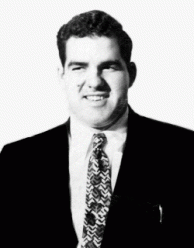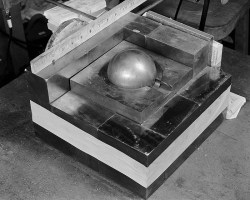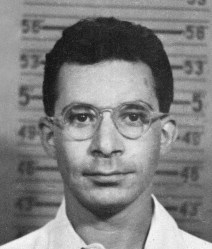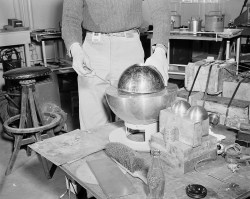Harry Daghlian and Louis Slotin were two of many people who worked on the Manhattan Project. They might not be household names, but we believe they are the poster children for safety procedures. And not in a good way.

Slotin assembled the core of the “Gadget” — the plutonium test device at the Trinity test in 1945. He was no stranger to working in a lab with nuclear materials. It stands to reason that if you are making something as dangerous as a nuclear bomb, it is probably hazardous work. But you probably get used to it, like some of us get used to working around high voltage or deadly chemicals.
Making nuclear material is hard and even more so back then. But the Project had made a third plutonium core — one was detonated at Trinity, the other over Nagasaki, and the final core was meant to go into a proposed second bomb that was not produced.
The cores were two hemispheres of plutonium and gallium. The gallium allowed the material to be hot-pressed into spherical shapes. Unlike the first two cores, however, the third one — one that would later earn the nickname “the demon core” — had a ring around the flat surfaces to contain nuclear flux during implosion. The spheres are not terribly dangerous unless they become supercritical, which would lead to a prompt critical event. Then, they would release large amounts of neutrons. The bombs, for example, would force the two halves together violently. You could also add more nuclear material or reflect neutrons back into the material.
First Incident

In August of 1945, physicist Harry Daghlian was performing an experiment on the core. He was alone, but a security guard was about 10 feet away. The experiment involved placing neutron reflector bricks around the core to get it closer to supercriticality. However, Daghlian accidentally dropped a brick on the core, causing it to go supercritical. He quickly removed the brick, but not before receiving a fatal dose of radiation.
The 24-year-old physicist died 25 days later. The 29-year-old security guard fared better. He received a much smaller dose and died 33 years later at the age of 62. He did, however, die from leukemia, which may or may not have been related to radiation exposure.
But Then…

The point is people knew these materials could easily turn deadly. In 1946, Louis Slotin performed a similar experiment. Using Two beryllium half-spheres. The core would go in one half, and the other half would be lowered over the top using a thumb hole. Instruments measured the radiation as the beryllium sphere closed and opened. Shims were placed on them to make sure you couldn’t completely close the surrounding sphere, because that would push the core into the supercritical state.
Slotin was known as the expert on this particular test, and he shunned the standard protocol. Instead of using shims, he had one hand on the sphere and, in the other, a flat-blade screwdriver serving the function of the shims. Enrico Fermi had remarked to Slotin and some of his colleagues that they would be “dead within a year” if they kept to this test procedure. Fermi was a smart man.
It Happened
Of course, during one test, Slotin’s screwdriver slipped, and the reflective sphere enclosed the demon core. A flash of blue light and a wave of heat lasted about a half-second, during which Slotin received a dose estimated at 880 rem. For comparison, Daghlian took an estimated 290 rem, and X-ray exposures are in the millirem. Slotin later reported tasting a sour taste in his mouth and an intense burning sensation in his hand.

Slotin immediately flipped the top of the shield, and the reaction ceased. There were seven others nearby, but they received a much lower dose because Slotin’s proximity to the material acted as a shield. Slotin died in nine days at age 35, and from all descriptions, it was not a good way to go.
The next nearest person, who was about three feet away from the core, spent weeks in the hospital but died 19 years later of a heart attack; it is difficult to prove or disprove this was due to the radiation. He did have chronic neurological and vision problems, though. Two others were also hospitalized. Most of the survivors lived for decades after, save one soldier who was killed in action in Korea four years later.
Slotin was hailed a hero for saving his colleagues. But it was also clear that his reckless behavior had precipitated the accident in the first place. It is also strange that the team’s film badges were locked away 100 feet from the experiment.
The core had been known as Rufus but was now the “demon core.” One of the survivors of the accident would go on to design remote control equipment to perform these sorts of experiments with the researchers at least a quarter-mile away. As you might expect, future “hands-on” work was strictly forbidden.
The demon core was melted down and used to make smaller test cores. There have been several other critical events, most of them fatal, over the years. But it is doubtful that any of the materials involved in those accidents had the chance to strike twice.
Lesson Learned
How often do we take shortcuts with deadly things we are overly familiar with? Working on a live mains circuit comes to mind. Handling chemicals with poor ventilation. Sure, it isn’t nuclear material, but dead is dead. You don’t get points for having a cleaner accidental death.
The British made a video about this kind of accident back in 1969, and it is still worth a watch.
Shims come up in a lot of these kind of stories. You’d think nuclear power plants would be bastions of safety, but sadly, it isn’t always the case.
















Wasn’t this article done recently? I’ve seen the Slotin incident pop up at least five times in the past few months.
Yes, me too, and such things happen quite often.
It’s some computer algorithm that decides to push such things into everyone’s face all over the ‘net.
Are you not aware that there is currently a very popular and successful 3 hour movie about the Manhattan Project in theaters?
isn’t it much more about Oppenheimer than the Manhattan project?
Not again. It is everywhere. It must have been in Barbiheimer?
I was thinking a Demon Core fondue pot would be good decor for a science-theme Halloween party.
Little blue LED under a metal hemisphere lid. Lift the lid a little and reach in with a long-handle fondue fork.
That would be epic.
Make that long handled standard screwdrivers, then shut up and take my money.
The idea is that there’s melted cheese or something inside, and you use the long-shafted fork to dip edible things in it. I think sometimes it’s chocolate instead of cheese.
Porque no los dos?
https://www.pbswisstools.com/de/werkzeuge/quality-hand-tools/sonderwerkzeuge/produkt/pb-4040-set-pet
https://hackaday.com/2022/08/31/building-a-glowing-demon-core-lamp/
The artwork for this article is Rad! 😈
It looks less evocative of a demon though and reminded me more of the devil bunny from Donnie Darko.
It’s not like they didn’t know what they were working with… Like Mary Curie didn’t know. But these guys knew the risks fully well. If they weren’t tired of life, what then caused them to take such risks for such low gains? I mean: how many seconds a day do you win by using a screwdriver instead of a shim? And compare that to how many years of life you loose when something goes wrong?
These boys should simply not have been given charge over what they were doing.
In any case, if my colleague would be so reckless and put both his life and mine on the line with his recklessness, I would and kick his ass all the way out of the front door.
And I wouldn’t expect any complaint of him, because having your ass kicked like that is still in every way better and less painful than dying of radiation sickness over the cause of several days. I even expect them to thank me afterwards…
Safety hadn’t quite been invented yet.
“Jon H says:
August 15, 2023 at 7:55 am
Safety hadn’t quite been invented yet.”
That’s simply not true. Feynmann was sent on a trip to Oak Ridge precisely to make sure they followed proper procedures to avoid a criticality incident. It’s similar with firearms: there are no accidental discharges, only negligent discharges.
I thought part of the story was he took a piece of chalk and everybody marked on the floor where they were standing, so they could tell how far each person was from the core when exposed.
I read that Slotkin really didn’t want to be there. He had been trying to return to Canada, but his experience assembling bombs made him too valuable so he was stuck in NM. There was an incident before the criticality incident where he dove into a cooling pond rather than waiting for the right equipment to retrieve something, if I remember right. So, maybe not so much of an “accident” as a cry for help.
> “It stands to reason that if you are making something as dangerous as a nuclear bomb, it is probably hazardous work. But you probably get used to it, like some of us get used to working around high voltage or deadly chemicals.”
It’s possible to get used to radiation, as long as it isn’t a strong one.
Speaking from experiance, my mother was radiated (nearly 14 years) for cancer while i was growing up from baby. About 6 months after she died i had a big problem with nose bleeds what was the result of the missing radiation. After about 2 years it when back to normal in 1971.
Your nosebleeds were not caused by “missing” radiation.
That’s one of the strangest claims I’ve ever heard. It’s untrue as well.
I believe it.
Naysayers, begone!
Opportunity!
Clearly you are a very intelligent man and not a credulous fool. I have a business opportunity for you.
They are going to tear down the Brooklyn bridge and I am in charge of selling off the scrap. Please respond.
@Wade and @mythoughts62: My medical records provide my statement, they (hospital) did lots of tests as it was also new for the medical team. For 5 years i was under medical control.
Do you perchance think chemtrails exist?
Almost nobody is going to die of Acute Radiation Syndrome with a dose of “just” 2.9 Sieverts (290 rem).
Daghlian received an estimated 5.1 Sv which is far enough over the LD50 of 4 Sv that he was fairly certain to die. Especially with the knowledge and treatments available in 1945.
The uncertainty over the exact amount is -50 to +200%.
Here’s a link to a paper about a whole bunch of criticality accidents. A fascinating read:
https://sgp.fas.org/othergov/doe/lanl/docs1/00538245.pdf
Thanks!
Part-Two:
lib-www.lanl.gov/la-pubs/00538246.pdf
Over-familiarity with explosives, poisons, other volatile chemicals etc. has historically always bred stupid accidents like these. Soldiers in the first world war got too used to being around shells and bombs and generally became nonchalant about death, and so they would frequently blow themselves up by tinkering with mortars and shells, including duds that had still-active fuses, collect them and horde them in their dugouts until they blew up a huge portion of their own line, crazy stories like that. Ernst Junger blew a finger off because he picked up a rifle grenade off the ground and started absent-mindedly poking at the percussion cap with the end of his pipe. Nonchalance with such dangerous things became a very significant problem. And as we can see, even very intelligent people like these nuclear physicists can become over-familiar and careless when they are around these things too often.
Happens in Ukraine too. I have saved at least a couple of videos where soldiers were transporting unfused anti-tank mines in open-top dump truck or storing them in a huge pile. What could possibly go wrong? It’s just /safe/ plastic explosive.
There are anecdotes from the Gulf War about soldiers burning C4 to heat meals, as it is chemically similar to Esbit(hexamine) fuel.
Well, honestly, C4 is soooooo safe and it purns just fine so long as it is not confined… if you try to stomp it out you could lose a foot, or worse.
so what? c4 is ruddy hard to initiate.
It’s a bit like putting backup generators of a nuclear power plant on the shore behind a shallow dyke in a Tsunami prone area.
From what I remember, that was also reported and it was known the dykes were too shallow years before it became a problem.
Leaving the doors open of a RORO ferry has also happened a few times.
https://en.wikipedia.org/wiki/Roll-on/roll-off
I remember the “Harald of Free Enterprise” near the Belgium coast, and another some 15 years later somewhere near Poland. And overall, there are thousands of serious accidents because of nonchalance.
I just saw a video about this, stupid safety procedures.
A Vital Error: The Zeebrugge MS Herald of Free Enterprise Disaster 1987
https://www.youtube.com/watch?v=juk-AJ6xUQo&t=605s
1) not just the generators but the batteries along with the entire emergency electrical panel being on ground level
2) concerns about this were raised by the Japanese side but ignored during construction (it’s a GE design)
3) TEPCO never actually ran emergency cooling procedures. If they did, nobody would’ve been concerned by it and they would’ve left it on instead of turning it on and off, as they feared heat-shocking the reactor. Power was lost during the off phase with switch in the on position (the valves didn’t have time to open) with some steam leaving the vents, leaving the operators believing it’s on. Had they actually seen how much more steam comes out the vents during a live exercise, far less valuable time would’ve been lost just waiting…
Since none of the persons present during the Slotin incident were wearing badges, Slotin himself calculated the approximate radiation everyone in the room had received, based on his estimates of where everyone was standing. Slotin correctly predicted that only he had received a fatal dose.
“Gentlemen, it’s been good to know you.”
I think the lesson learned is you shouldn’t tickle the dragon’s tail, much less try to give it a prostate exam.
Stealing this …. lol
Use it wisely my friend.
This shouldn’t have produced the roarious laugh I’m doing right now but tears are coming and I thank you for it. lolol
I love the nick name for the test procedure: “tickle the dragon’s tail”
Richard Feynman, the famous theoretical physicist who worked on the Manhattan Project, cautioned against the experiments, saying that they were like ‘tickling the tail of a sleeping dragon.’ – https://en.wiktionary.org/wiki/tickle_the_dragon%27s_tail
Shortly before my first business trip to Japan, there was an accident at a nuclear fuel-rod recycling plant, which was (amazingly) situated in a populated area close to Tokyo. In my understanding, the fuel-rod material was concentrated in containers that were designed to be too small to contain a critical mass BUT highly enriched rods were mistakenly introduced to the process line. A critical mass was created and a contamination event was triggered. Perhaps mistakenly, I trusted that Japan would have reacted sensibly to this event (I do think they did) and I continued with my visit (I’m still going ~25 years later, so I suppose I made the right decision). Safety protocols should NEVER be sneered at.
If it was the same event I’m remembering it was a case of Japanese workers overdelivering.
The procedure involving small containers took to long. So the workers improvised a new process. Metal buckets.
Your average American worker doesn’t have that kind of initiative. They got a big bonus for their efforts (measured in Sieverts).
They poured too much uranium oxide liquid into a tank. https://science.howstuffworks.com/hisashi-ouchi.htm Ouchi’s chromosomes were blasted to pieces. His cells couldn’t divide and other cellular processes stopped so he essentially fell apart over the course of 83 days. At 60 days his heart stopped but the doctors revived him. It would have been compassionate to have let him go then.
At 17 Grays absorbed dose, the compassionate thing to do would have been to hand him a cyanide capsule after the amount of exposure became clear. Then he wouldn’t have had to spend 83 days shitting himself to death as his insides dissolved. There is zero point zero zero chance of survival with a dose that high. The medical response prolonging his agony was unethical if not criminal.
From your cite:
Ouchi was standing at a tank, holding a funnel, while a co-worker named Masato Shinohara poured a mixture of intermediate-enriched uranium oxide into it from a bucket.
They were overdelivering for their employer. Ignoring the official process, using a bucket instead. Like I said, you don’t get that kind of initiative from American workers.
This is the death penalty case of using a screwdriver as a pry bar. Seriously though the whole idea was incredibly dumb. As far a developing a remote system, it would have been as easy as using a rope and pulley from behind a lead shield. Just a guy thinking he would never make a mistake. Arrogance kills a lot.
Unfortunately, lead shields are less effective for neutron radiation, but make the rope much longer and hide in a trench and you’re onto something :)
How about naming a drink after Louis? Blue Curaçao and orange juice. Call it the Slotin Screwdriver.
It was my understanding that the ‘blue flash’ was Cerenkov radiation which is when the radiation released by fission exceed the speed of light *for the medium which they’re passing through*.
So you’ll only see it when the radiation is interacting with, for example, the water surrounding the core of a reactor or, much more unpleasant, when it’s passing through the aqueous humour contained in your eyeballs.
There’s another form of blue glow too – ionized-air glow. Basically why lightning looks blue. Cherenkov radiation, as you say, does not occur for neutron radiation in air (but you might for higher-energy particles).
A Review of Criticality Accidents LA-13638 (2000 revision)
https://ncsp.llnl.gov/sites/ncsp/files/2021-11/000.la-13638.pdf
“The gallium allowed the material to be hot-pressed into spherical shapes.”
It also freezes it into its lower density delta allotrope resulting in a greater degree of compression during its implosion. I was very interested in nukes in my younger days and still am. Back then, I wanted to check out a book at the library that was in the card catalog, but I couldn’t find it on the shelves. I asked the librarian and he said something like “We keep that in the back.” It was an older book and I think the title was something like “Plutonium Metallurgy.” It wasn’t a reference book which couldn’t be checked out and yet it was kept off the general circulation shelves. Hmmm…
Anyway, in the book it had a periodic table showing the metals with which plutonium had been alloyed and for which there was data in the book… EXCEPT gallium. Every metal around it on the table was marked, but not it. LOL, was that a giveaway or what? So, I went to the National Technical Information Service index looking for any title containing gallium and found a report titled something like “Corrosion of Plutonium with 1% Gallium in Hotbox Atmospheres” originating from the Rocky Flats facility which made the fissile pits. The end.
Anyway, these days, there are huge amounts of nuke tech info on the web, much of which is borrowed from the late, great Theodore Taylor’s highly technically detailed CD-ROM set “Swords of Armageddon.” Or like here:
Plutonium and Its Alloys: From atoms to microstructure
Siegfried S. Hecker
https://sgp.fas.org/othergov/doe/lanl/pubs/00818035.pdf
Oops, that was Chuck Hansen’s “Swords of Armageddon,” not Theodore Taylor’s, the nuclear weapon designer. But Theodore did reveal a whole bunch of fascinating info in this article I’ve never seen anywhere else:
https://cdn.makezine.com/make/strangelove.pdf
Theodore Taylor also wrote the great book, “The Curve of Binding Energy” about his days as a weapons designer and other related topics. He lit a post test success cigarette from one of his designs being tested using a small parabolic mirror and a DIY cigarette holder at its focal point.
Too bad we haven’t invented the real life equivalent of Rad Away or RadX ( Fallout 4 ) ( The whole series actually )
Where you get a high dose of radiation and you just pop a pill 💊 & boom ALL CURED!! lol… Maybe after we’ve perfected Nuclear Fusion we’ll be able to instantly negate the harmful effects of radiation..
If you like these types of stories, I recommend “Atomic Accidents: A History of Nuclear Meltdowns and Disasters; From the Ozark Mountains to Fukushima” by James Mahaffey. I got it as an ebook in a Humble Bundle and am re-reading it for the 2nd time.